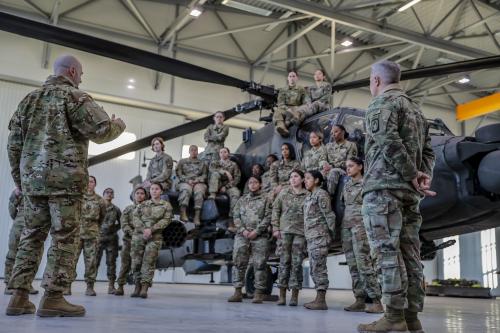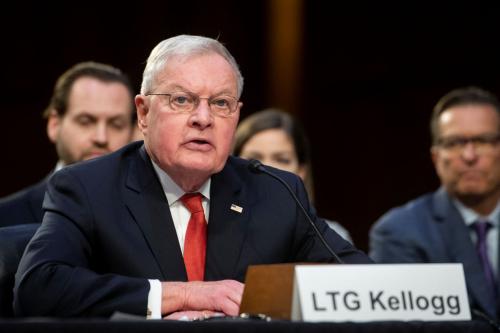Introduction
Mr. Chairman, it is an honor and great pleasure to appear before your subcommittee to testify on the nuclear situation in Russia. Certain developments in Russia pose increasing nuclear danger to the United States, and I appreciate the opportunity to draw Congressional and public attention to them.
Two trends are especially prejudicial to our security. First, Russian security policy continues to shift toward an exclusive emphasis on nuclear weapons. Russian planners rely more than ever on these weapons, on their widespread dispersal, and on their first use in a crisis. Second, Russian control over its nuclear arsenal is tottering on the brink of collapse, raising the specter of the accidental, illicit and inadvertent use, or the theft, of Russian nuclear weapons and fissile materials. This is a deadly combination fraught with risk. Growing reliance on intentional quick use in a crisis and growing susceptibility to unintentional use means that the nuclear situation is more unstable and perilous today than it was during the Cold War. And it cannot be endured indefinitely. Russia’s nuclear circuits are too overloaded to count on them not blowing sometime in the future. It is not at all unreasonable to anticipate a catastrophic failure of Russian nuclear command and control.
This less than rosy assessment challenges the prevailing wisdom within the U.S. government, but the assessment rests on a considerable body of evidence. Let me elaborate on a part of the thesis.
We all know that Russia grew more dependent on nuclear weapons following the disintegration of its regular conventional army. That puts Russia’s nuclear doctrine and strategy in the spotlight, where two disturbing strands are evident.
First-use of Tactical Nuclear Weapons
One of these strands is the growing expectation among Russian planners that they could be forced to initiate the use of tactical or theater nuclear forces during a regional crisis involving NATO or China. This doctrinal shift abandoning their no-first-use pledge of 1982 became evident in Russia’s draft military doctrine in May 1992, a shift confirmed by Russia’s new doctrine officially promulgated in November 1993. Defense Minister Rodionov has long been a proponent of such change, and by all accounts the forthcoming revision of Russian military doctrine will codify the change. Recent statements from senior Russian security officials including the Security Council Secretary, Ivan Rybkin, and President Yeltsin’s Defense Advisor, Yuri Baturin, leave little doubt on this score. In short the tables have turned on Russia. It plans for compensate for conventional inferiority with nuclear weapons.
This growing reliance on nuclear weapons might cause Russia to reverse course on tactical weapons consolidation, redeploying them on ships at sea, particularly on the Baltic and Black Sea Fleets, on tactical aircraft, and on a new short-range tactical missile now being tested. Many of these tactical forces could wind up deployed along Russian borders, in Kaliningrad, and in Byelorus. Such dispersal not only might lower the threshold for their intentional use during a crisis, but it also would compromise operational safety. Of all the types of weapons, tactical nuclear weapons unfortunately have the poorest safeguards. Those built before the early 1980s lack the safety locks known as permissive action links. Further dispersal of Russia’s 22,000 tactical nuclear weapons beyond the many dozens of depots already in use would represent a serious setback for operational safety as well as safeguards against theft.
Launch on Warning/First-Use of Strategic Nuclear Forces
The second disturbing strand in Russian strategy concerns the strategic nuclear forces, whose main option today is launch on warning—that is, launching strategic missiles after an enemy missile attack is detected, but before the incoming enemy missiles arrive. Assessments by the Russian General Staff conclude that if their strategic forces are not launched on warning, then only a small fraction, and possibly none at all, would be able to retaliate after absorbing a systematic attack. This estimate partially reflects the steep decline in the combat readiness of Russia’s least vulnerable forces—submarines at sea and mobile ICBMs in the field. But it also reflects Russian fear of D-5 missiles on U.S. Trident submarines, whose high accuracy and short flight times reinforce Russian reliance on quick launch, at the same time that they threaten to deny Russia that option.
Russia’s heavy reliance on this option means that its early warning and nuclear release procedures require a response time of 15 minutes in total; they allow only three or four minutes for detecting an attack, and another 3 or 4 minutes for top level decision making. The Russian command system is thoroughly geared to operate within these constraints of time, and we have observed it practicing the option during numerous exercises.
Its obvious this is not a safe operational practice. It’s inherently dangerous, and it’s compounded by the deterioration of Russia’s command-control system and missile attack early warning network, which are falling on hard times like the rest of the military infrastructure. To illustrate, recall the serious false alarm in January 1995, triggered by the firing of a Norwegian scientific rocket, which for the first time in Russian history triggered a strategic alert of their LOW forces, an emergency nuclear decision conference involving their President and other national command authorities, and the activation of their famous nuclear suitcases.
The Russian General Staff can exercise its nuclear quick draw in either of two ways. One is by sending unlock and launch authorization codes directly to individual weapons commanders, who then perform the launch procedures. (The General Staff and the KGB evidently shared joint custody of these codes at the General Staff war rooms until after the 1991 coup attempt. Today, the General Staff alone possesses these codes under normal peacetime conditions; plans exist to extensively distribute the codes and pre-delegated launch authority down the chain of military command during a nuclear crisis.) Or, the General Staff can personally push the launch button from war rooms in the Moscow vicinity. This is a remote, robotic-like launch of land-based strategic missiles that would totally bypass the subordinate commanders and missile launch crews down the chain of command. In any case, nearly 2,000 strategic warheads on launch-ready alert, mostly on silo-based missiles but partially on alert submarines on the surface at piers, could be fired on warning.
Russian planners recognize the difficulty of launching on true warning as well as the danger of launching on false warning. The pressure on the command system under such tight time constraints is certainly acute. To relieve some of this pressure, Russia has several options.
First, it could shift toward a policy of preemptive strike, a first-strike strategy for the strategic forces that would complement the ongoing gravitation of military doctrine toward the first use of tactical nuclear forces. This preemptive option holds out significant appeal to some strategic planners (probably a distinct minority).
Another response would be to fine-tune launch on warning by further streamlining the authorization process. Let us hope Russia does not go so far as to adopt the kinds of extraordinary measures considered during the early 1980s to cope with the perceived threat of decapitation posed by Pershing II missiles. For example, the Soviets developed and tested a command link meant to give the top political leadership push-button launch control over a portion of their ICBM force, bypassing even the General Staff, in order to shave off a few minutes of launch reaction time. Such short-cuts are obviously dangerous in the extreme.
A response designed to mitigate the danger of launching on false warning has already been adopted. Russia devised a back-up method of launch known as Perimeter, which they colloquially call the “dead hand.” If top leaders do not get a clear picture of an apparent missile attack, or if for any reason they fail to give timely authorization to retaliate, the General Staff can activate this system to ensure quasi-automatic retaliation in the event of their decapitation.
Status of Russian Strategic Missile Detargeting
Presidents Clinton and Yeltsin have created the widespread impression that U.S. and Russian strategic missiles no longer pose an immediate nuclear threat to each country’s population because of an agreement signed in early 1994 to stop aiming those missiles at one another after May 1994. In reality, the steps they took to implement their pledge were entirely cosmetic and symbolic. Neither removed the wartime aim points from their missiles portfolios of preprogrammed targets. Neither lengthened the amount of time needed to initiate a deliberate missile strike. And the risk and consequences of an accidental or unauthorized launch were not significantly affected by their pledge.
So what actually has been done to honor the agreement? In the case of Russia, no one knows for sure because no provision was made for verification. But let me clarify some of the crucial details based on my research findings.
To fulfill their obligations, the Russian military set their intercontinental missiles on what they call a “zero flight plan.” This setting sounds good, but it is nothing more than a symbolic gesture because the missiles’ memory banks still retain their wartime aimpoints. (Each missile stores several targets in memory.) If Russia decides to launch strategic rockets, a single order sent from Moscow to the rockets over an automated computer network is all that it would take to reprogram all of them for their wartime targets. The time required for this retargeting is a scant ten seconds.
To be more specific, the Russian General Staff, from their wartime command posts in Moscow, Chekhov, Penza and elsewhere, can use a computer network called Signal-A to override the Clinton-Yeltsin de-targeting agreement and re-aim all their silo-based missiles at the United States in 10 seconds.
And what if a strategic missile is launched accidentally or illicitly? At the moment of launch, it automatically would switch from its “zero flight plan” back to its primary wartime target, which might be Chicago, a Minuteman silo in Montana, London, Paris, or Beijing, among other possible destinations. In short, Russia did nothing to diminish its missile threat to the United States. On the available evidence, it is wrong to suggest otherwise. (Let me note parenthetically that U.S. missiles can be re-aimed at Russia just as quickly, and that a U.S. missile launched by mistake will not fly to its Cold War target but instead will land in the ocean. In the event of an illicit U.S. launch, the missiles could easily be re-targeted for their wartime destinations.)
Conclusion
The moral of the story is that our nuclear security remains entwined with Russia’s nuclear doctrine, strategy, operational practices and safeguards. We need to make fundamental changes in U.S. policy to get real traction on the danger of weakening nuclear control in Russia, a danger that in my opinion vastly exceeds the danger that Russia would ever launch a deliberate attack. To reduce Russia’s reliance on nuclear weapons, their extensive dispersal, and “hair-trigger” posture, we must cooperate to develop mutual confidence and strengthen mutual security. Various means of passive and active protection from this danger, particularly national ballistic missile defense, also need to be thoroughly examined and evaluated.
Note: In accordance with House Rule XI, Clause 2 (g), Bruce G. Blair received $0 in federal grants and contracts during the past three fiscal years. He does not represent, but is affiliated with, the Brookings Institution. His views are personal, not official Brookings views. The Brookings Institution received approximately $400,000 (2% of its annual budget) in federal grants and contracts during each of the past three fiscal years. None of these funds were in support of the Foreign Policy Program at the Brookings Institution to which Bruce Blair is assigned.
The Brookings Institution is committed to quality, independence, and impact.
We are supported by a diverse array of funders. In line with our values and policies, each Brookings publication represents the sole views of its author(s).



Commentary
TestimonyRussian Nuclear Policy and the Status of Detargeting
March 17, 1997